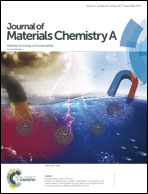Facile synthesis of metal hydroxide nanoplates and their application as lithium-ion battery anodes†
Abstract
We report a facile approach to synthesize hexagon-shaped nanoplates of various metal (oxy)hydroxides under aqueous solutions while avoiding complex processes. This synthetic method can be generally applied to fabricate various nanoplates, including not only single-metallic (oxy)hydroxides such as Co(OH)2, MnO(OH), FeO(OH), and Mg(OH)2 but also mixed-metal (oxy)hydroxides, where each metal component is homogeneously distributed and the atomic ratio of the metal species can be easily controlled by varying the precursor ratio. Carbon-coated metal oxide nanoplates, which are prepared by coating of polydopamine followed by heat treatment, are applied as anode materials for lithium-ion batteries (LIB). Core–shell nanoplates of CoO@C, MnO@C and Fe3O4@C exhibit excellent cycle stability with a high specific capacity of ∼1000 mA h g−1. In particular, the effect of carbon shell thickness on electrochemical performance is studied using CoO@C nanoplates with different carbon shell thicknesses. CoO@C with a 6.5 nm-thick carbon coating exhibits good cycling performance and maintains a high rechargeable capacity of 997 mA h g−1 even after 100 cycles at a current density of 200 mA g−1, while CoO@C with a 1.5 nm-thick carbon shell shows a significantly decreased capacity of 315 mA h g−1 after the 100th cycle.



 Please wait while we load your content...
Please wait while we load your content...